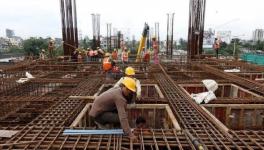Household Savings at 6.5% of GDP in 2018-19, Lowest Since 8 Years: NSO
India’s net household savings have fallen to 6.5% of gross domestic product (GDP) in 2018-19, lowest in the last eight years, as per the latest data by the National Statistical Office (NSO).
NSO released the first revised estimates (RE) of ‘National Income, Consumption Expenditure, Saving and Capital Formation’ for the financial year 2018-19 along with RE for 2017-18 and 2016-17. For this, NSO has adopted a new methodology after due deliberations with the Reserve Bank of India.
Household savings is defined as the difference between a household’s disposable income and its consumption of goods and services.
The fall in the household savings has been triggered by the fall in gross national savings and increase in liabilities. The gross savings during 2018-19 was estimated at Rs 57.13 lakh crore against Rs 55.38 lakh crore during 2017-18. NSO has estimated a decrease in the rate of gross savings to Gross National Disposable Income for 2018-19 at 29.7% against 32.0% for 2017-18.
Also watch: 10 Things No One Told You About The Economy
According to the new tax regime announced in the union budget, the taxpayers will be allowed to pay lower tax only if they forgo tax exemptions on savings such as provident funds and insurance among others. However, this is optional as the taxpayers are also allowed to choose the previous tax slabs with higher tax rates with exemptions.
“It is surprising that a tax policy that does not incentivise savings has come when the savings rate in India is low, and declining, too. Savings form the pool available for investments, and long-term household savings are especially crucial for investments in infrastructure,” said Ila Patnaik, teacher at the National Institute of Public Finance and Policy.
As of now, fall in savings is not a worry, said former chief statistician Pronab Sen. Speaking to CNBC TV18 on this matter, Sen noted, “Whether the change in income rate is going to lead to a shift in behaviour is very difficult to say because we really don’t know what is driving it. I don’t think we need to worry too much about the savings at the moment, because in India, most household savings are not that sensitive to interest rates. What they are sensitive to is people’s expectations about the future.”
The data has also indicated a drop in the growth of net national income. “Nominal Net National Income (NNI) at current prices for the year 2018-19 stands at Rs 167.89 lakh crore as against Rs 151.50 lakh crore in 2017-18, showing growth of 10.8% during 2018-19 as against 11.2% in the previous year,” stated the report.
Additionally, NSO estimated per capita net national income at current prices as Rs 1,15,293 and Rs 1,26,521, respectively for the years 2017-18 and 2018-19.
Financial year 2018-19 has also witnessed relatively lower growth rate across all sectors. “During 2018-19, at constant prices, the growth rates of Primary (comprising Agriculture, Forestry, Fishing and Mining & Quarrying), Secondary (comprising Manufacturing, Electricity, Gas, Water Supply & Other Utility Services, and Construction) and Tertiary (Services) sectors have been estimated as 1.0%, 6.0% and 7.7% as against a growth of 5.8%, 6.5% and 6.9%, respectively, in the previous year,” stated NSO.
Also read: Criminal Callousness of Modi Government in Hiding Data
Get the latest reports & analysis with people's perspective on Protests, movements & deep analytical videos, discussions of the current affairs in your Telegram app. Subscribe to NewsClick's Telegram channel & get Real-Time updates on stories, as they get published on our website.
























